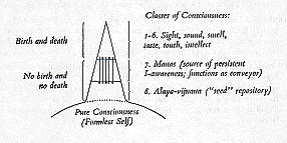 |
|
.
e
.
n
 |
 |
 |
 |
 |
 |
 |
 |
 |
 |
 |
 |
 |
 |
|
STORIES, BOOKS & MEDIA
» koans, stories & words » zen readings » recommended books » book reviews » art & prints » audio, videos, DVD's ZAZEN MEDITATION GUIDE - Chapter 17. The Differences between Buddhism and Zen There is a question that is often raised by people who are interested in Zen Buddhism for the first time, "What is difference between Buddhism and Zen?I have the main points for you here: "After the Buddha passed away, not too long, a couple of centuries perhaps – his teachings were interpreted in many different ways. These depended on each individual's understanding of his disciples. Buddhism formed into two great systems: Theravada or as it's often called Hinayana: the Small Vehicle, that is, the small car only can carry one person to nirvana, it's ideal type of person is an Arahat (a perfect saint) and; Mahayana or the Great Vehicle, that is, the bigger car that can carry many people at the same time to enlightenment, the ideal person of it is a Bodhisattva, a person who is on the way to the Supreme Enlightenment of the Buddha. Then, about the first century A.D. came Nagarjuna, one of the greatest Buddhist masters of all times. His position is just after the Buddha himself. He founded the Madhyamaka (Middle Path) School with the Doctrine of Sunyata (Emptiness). Almost all Buddhist schools' teachings based on this Doctrine, including Zen teachings. What is the Sunyata? And I declare that they are Emptiness.And he describes the Sunyata as follows: No arising and no ceasingIs there any relation between this Sunyata and the Empty House which Zen master Lung-ya referred? About two hundred years after Nagarjuna, another of the greatest schools was founded by Maitreyanatha, and it was called Yogachara school, then established by Asanga and Vasubandhu and it got a new name: Vijnanavada (Mind-only) school.  I would like to borrow the following diagram based on a scheme by Harada Sogaku Roshi, a famous and contemporary Japanese Zen master, to introduce you the main ideas of the doctrine of the Mind-only school and if you take a close look at the relation between the classes of consciousness you can figure it out yourself where we will start, go through, and end up with according to the teachings of this school. 3
The doctrine of this school can be summarized in this well known statement: "The threefold world (of desire, form, and formlessness) is mind-only"; ten thousand things are consciousness-only. The teachings of these two greatest Indian Buddhist schools have remained and developed in many other Asian countries such as China, Tibet, Japan, Korea, Vietnam... and now at many places in the world, along with them, the Theravada system. I would like to borrow the following diagram based on a scheme by Harada Sogaku Roshi, a famous and contemporary Japanese Zen master, to introduce you the main ideas of the doctrine of the Mind-only school and if you take a close look at the relation between the classes of consciousness you can figure it out yourself where we will start, go through, and end up with according to the teachings of this school. 3
The doctrine of this school can be summarized in this well known statement: "The threefold world (of desire, form, and formlessness) is mind-only"; ten thousand things are consciousness-only. The teachings of these two greatest Indian Buddhist schools have remained and developed in many other Asian countries such as China, Tibet, Japan, Korea, Vietnam... and now at many places in the world, along with them, the Theravada system.
So far, there are at least ten great sects in Mahayana Buddhism such as Pure Land school with its main practice of praying in the name of Amita (i.e. Infinite Light or Infinite Longevity) Buddha who lives in the Western Paradise. Another school is San-lun (Three Treatises) school, or the Madhyamika school in China, Japan , Korea, and Tibet. This school actually no longer exists in China... but still exists in Tibetan Buddhism and now is spreading strongly in the West, especially in America through many Tibetan Buddhist masters. The third one is T'ien-ts'ai (Tendai, in Japanese) school which was founded by Chih-i (538-597), one of the greatest Chinese Buddhist masters, its doctrine based on the "Lotus Sutra" and its main practice is the Samantha-vipashyana, one of the Buddhist meditation methods. The fourth one is Ch'an in Chinese (or Zen in Japanese) school. Its founder was Bodhidharma, an Indian Buddhist master who came to China about the latter half of the 5th century and the first half of the 6th century. The main message which Bodhidharma sent to us, you already saw at the beginning of this guidelines: "Not establishing words and letters,To help people who would like to attain kensho (seeing into one's own nature), Zen masters have devised many different methods. The four main ones of them are: counting your breaths out and in, following your breaths with your mind's eye, mao-chao (silent illumination) or shikantaza (just sitting in your whole awareness), and working with a koan. Actually, the practices of this school are grounded in the Way of the Buddha: dhyana (or meditation) which the Buddha did at least for six years until he became enlightened. Its teachings are based on the teachings of the Buddha in the "Mahaprajnaparamita-sutra" (The Large Sutra on Perfect Wisdom) which the doctrine of emptiness of Nagarjuna is based upon, and the Teachings of the Buddha in the "Lankavatara-sutra" which the doctrine of Mind-only of Vasubandhu is based. Sometimes the teachings of the Buddha in the "Avatamsaka-sutra" can be seen in Zen, too. Therefore, it can be said that the teaching system of Zen Buddhism is an integrity of the whole of Mahayana Buddhism. When the Yogachara school, (The precedent of the Vijnanavada school), was first brought by Padmasambhava to Tibet, it adopted some features of the native cult that existed there: the Bon religion of the Tibetan people and its associated mysticism was one of its characteristics. In Tibetan Buddhism, there is another school called Dzogchen that has some characteristics somewhat similar to Zen. Despite of how much different those schools seem to be in appearance, that is, the rituals and practices, they all have the same ultimate goal - to help anyone who likes to learn and practice what the Buddha taught: to become enlightened, liberate oneself from suffering caused by greed, anger, and ignorance and then if he likes, he can help others do the same thing. What I have just said above are just some simple words on some main ideas, and I won't go into the other sects of Buddhism because I think it is enough for now in this guideline. If you want to go further into them, you might need to read some books on them such as "The Essentials of Buddhist Philosophy" by Junjiro Takakushu. There are a couple of things here I would like to make clear: Firstly, there are many different methods of meditation which are used in the different Buddhist schools. For example, the methods that are used in the Tibetan Buddhist schools can be called "the methods of visualization" (except for Dzogchen), this means when a practitioner does one of these he needs something to rely on, usually an image or a sound. In Zen Buddhism, the methods are different from these. This means the practitioner does not have anything to rely on, especially in shikantaza. Secondly, when someone, a Westerner in particular, reads the teachings of the Buddha, for the first time, on the Four Noble Truth, they usually see that Buddhism shows us everything in this world is full of suffering, temporary, unreliable, deceitful ... Oh! too passive and too pessimistic... Yes, he is correct but this is just one step, or the First Truth of the Four Noble Truths. If he stops right there, he already misses the three more steps that he needs to go and see the whole thing. Furthermore, all the teachings of the Buddha and Zen masters are for not only reading but also for practicing. Suppose you could read all the Buddhist Scriptures and remember them all by heart. It would be in vain because you might not be enlightened yourself by remembering words. Instead of that, you must practice them, and only through practicing might you really understand them and awaken yourself. When you do awaken yourself entirely, you will not need to read or recite any Scriptures at all, because now, you are the source of all Scriptures. The same can be applied to the teachings of the Four Noble Truths and the Eightfold Path. Even you if know them by heart but you do not practice them, they will be no meaning at all. Finally, if Zen says something that seems to be against the Buddhist Scriptures or the concept of Buddha in the students' mind, that is Zen just wanting to wake up the deluded mind of the student. It has nothing to do with the historical Buddha or the Scriptures. Therefore, do not cling too much to the words and don't let they deceive you. You need to know where and what they are pointing to. Actually they did not try to deceive anyone. However, when someone does not understand what they really mean behind the words, then he or she would be deceiving himself/herself. Of course, words have some meanings in situations and they also have their own limits. This means words just play their role as a means of communication to some degree and not the Reality itself. If anyone just likes reading a menu but never eats the food, then how could he be full. As the Buddha teaches us: "Do not take the finger as the moon itself" or "My words are like a raft helping you to get to the other shore. When you are already there, do not take the raft on your shoulder and walk." If you like to experience something for yourself, you might want to practice one of the methods of sitting in meditation you have had described for you. 1 translated from Chinese 2 translated from Chinese 3 from "The Three Pillars of Zen" by Philip Kapleau. 4 translated from Chinese End of ZAZEN MEDITATION GUIDE - Chapter 17. The Differences between Buddhism and Zen
SUPPORT ZENGUIDE.COM Purchase posters, art prints, media (music CD & DVD)
 MONK IN SHAOLIN
MONK IN SHAOLIN
by Isabel Munoz →Puchase this Item →More Art Prints & Media →Zen & Buddhism books |
s
.
t
.
o
.
r
.
i
.
e
.
s
.
,
.
.
b
.
o
.
o
.
k
.
s
.
.
&
.
.
m
.
e
.
d
.
i
.
a
.